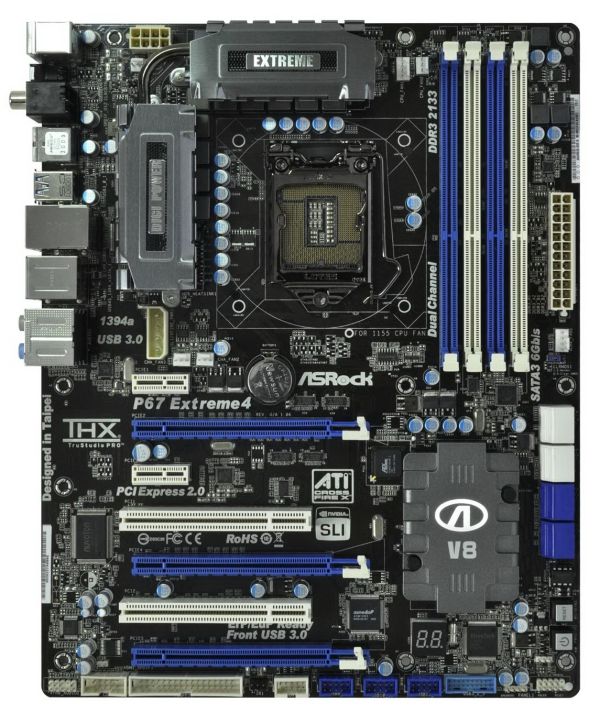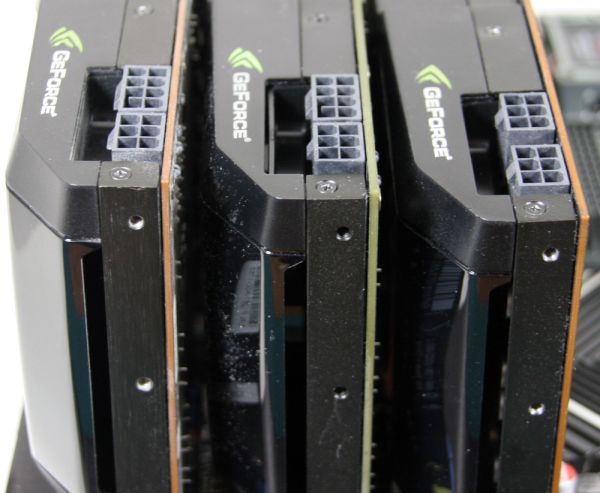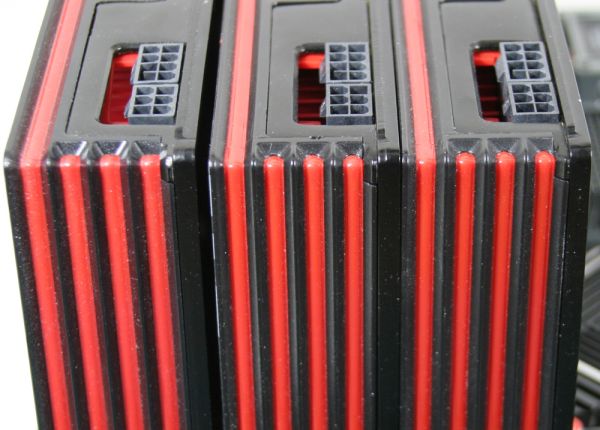A Look At Triple-GPU Performance And Multi-GPU Scaling, Part 1
by Ryan Smith on April 3, 2011 7:00 AM ESTFitting Three Video Cards in an ATX Case
I thought we’d flip our normal GPU review style on its head by starting with Power, Temperature, and Noise first. NVIDIA and AMD have both long recommended against placing high-end video cards directly next to each other, in favor of additional spacing between video cards. Indeed this is a requirement for their latest dual-GPU cards, as both the GTX 590 and 6990 draw relatively massive amounts of air using a fan mounted at the center of the card and exhaust roughly half their air inside of the case. Their reference style single-GPU cards on the other hand are fully exhausting with fans mounted towards the rear of the card. Thus multi-GPU configurations with the cards next to each other is supposed to be possible, though not ideal.
There’s a reason I want to bring this up first, and a picture is worth a thousand words.
While AMD and NVIDIA’s designs share a lot in common – a rear-mounted blower fan pushes air over a vapor chamber cooler – the shrouds and other external equipment are quite different. It’s not until we see a picture that we can appreciate just how different they are.
With the Radeon HD 6000 series, AMD’s reference designs took on a very boxy design. The cards fully live up to the idea of a “black box”; they’re enclosed on all sides with a boxy cooler and a black metal backplate. As a GPU reviewer I happen to like this design as the GPUs are easy to stack/store, and the backplate covers what would normally be the only exposed electronics on the card. The issue with this boxy design is that AMD is taking full advantage of the PCIe specification, leading to the 6900 series being the full width allowed.
NVIDIA on the other hand has always had some kind of curve in their design, normally resulting in a slightly recessed shroud around the blower intake. For the GTX 580 and GTX 570 they took a further step in recessing the shroud around this area, leading to the distinct wedge shape. At the same time NVIDIA does not use a backplate, saving precious millimeters of space. The end result of this is that even when packed like sardines, the GTX 580 and GTX 570 blowers have some space reserved for air intake.
The Radeon HD 6970 does not, and this is our problem. The picture of the 6970 in triple-CF really paints the picture, as the middle card is directly pressed up against the top card. Because these cards are so large and heavy the rear ends tend to shift and dip some when installed against a vertical motherboard – in fact this is why we can normally get away with a dense dual-CF setup since the bottom card dips a bit more – but in a triple-CF configuration the end result is that one of the cards will end up getting up-close and personal with another one.
Without outside intervention this isn’t usable. We hit 99C on the middle card in Crysis when we initially installed the three cards, and Crysis isn’t the hardest thing we run. For the purposes of our test we ultimately resorted to wedging some space between the cards with wads of paper, but this isn’t a viable long-term solution.
Unfortunately long-term alternatives are few if you want to give a triple-GPU setup more space. Our testbed uses an Asus Rampage II Extreme, which features three PCIe slots mixed among a total of 6 slots; the way it’s laid out makes it impossible to have our triple-GPU configuration setup in any other manner. Even something like the ASRock P67 Extreme4 can’t escape the fact that the ATX spec only has room for 7 slots and that when manufacturers actually use the 7th and topmost slot that it’s a short PCIe x1 slot. In short you won’t find an ATX motherboard that can fit three video cards and at the same time gives each one a slot’s worth of breathing room. For that you have to use a larger than ATX form factor.

So what’s the point of all of this rambling? With AMD’s current shroud design it’s just not practical to do triple-CF on air on an ATX motherboard. If you want to play with three AMD boards you need to think outside of the box: either use water cooling or use a larger motherboard.












97 Comments
View All Comments
taltamir - Sunday, April 3, 2011 - link
wouldn't it make more sense to use a Radeon 6970 + 6990 together to get triple GPU?nVidia triple GPU seems to lower min FPS, that is just fail.
Finally: Where are the eyefinity tests? none of the results were relevant since all are over 60fps with dual SLI.
Triple monitor+ would be actually interesting to see
semo - Sunday, April 3, 2011 - link
Ryan mentions in the conclusion that a triple monitor setup article is coming.ATI seems to be the clear winner here but the conclusion seems to downplay this fact. Also, the X58 platform isn't the only one that has more than 16 PCIe lanes...
gentlearc - Sunday, April 3, 2011 - link
If you're considering going triple-gpu, I don't see how scaling matters other than an FYI. There isn't a performance comparison, just more performance. You're not going to realistically sell both your 580s and go and get three 6970s. I'd really like if you look at lower end cards capable of triple-gpu and their merit. The 5770 crossfired was a great way of extending the life of one 5770. Two 260s was another sound choice by enthusiasts looking for a low price tag upgrade.So, the question I would like answered is if triple gpu is a viable option for extending the life of your currently compatible mobo. Can going triple gpus extend the life of your i7 920 as a competent gaming machine until a complete upgrade makes more sense?
SNB-E will be the cpu upgrade path, but will be available around the time the next generation of gpus are out. Is picking up a 2nd and/or 3rd gpu going to be a worthy upgrade or is the loss of selling three gpus to buy the next gen cards too much?
medi01 - Sunday, April 3, 2011 - link
Besides, 350$ GPU is compared to 500$ GPU. Or so it was last time I've checked on froogle (and that was today, 3d of April 2011)A5 - Sunday, April 3, 2011 - link
AT's editorial stance has always been that SLI/XFire is not an upgrade path, just an extra option at the high end, and doubly so for Tri-fire and 3x SLI.I'd think buying a 3rd 5770 would not be a particularly wise purchase unless you absolutely didn't have the budget to get 1 or 2 higher-end cards.
Mr Alpha - Sunday, April 3, 2011 - link
I use RadeonPro to setup per application crossfire settings. While it is a bummer it doesn't ship with AMD's drivers, per application settings is not an insurmountable obstacle for AMD users.BrightCandle - Sunday, April 3, 2011 - link
I found this program recently and it has been a huge help. While Crysis 2 has flickering lights (don't get me started on this games bugs!) using Radeon Pro I could fix the CF profile and play happily, without shouting at ATI to fix their CF profiles, again.Pirks - Sunday, April 3, 2011 - link
I noticed that you guys never employ useful distributed computing/GPU computing tests in your GPU reviews. You tend to employ some useless GPU computing benchmarks like some weird raytracers or something, I mean stuff people would not normally use. But you never employ really useful tests like say distributed.net's GPU computation clients, AKA dnetc. Those dnetc clients exist in AMD Stream and nVidia CUDA versions (check out http://www.distributed.net/Download_clients - see, they have CUDA 2.2, CUDA 3.1 and Stream versions too) and I thought you'd be using them in your benchmarks, but you don't, why?Also check out their GPU speed database at http://n1cgi.distributed.net/speed/query.php?cputy...
So why don't you guys use this kind of benchmark in your future GPU computing speed tests instead of useless raytracer? OK if you think AT readers really bother with raytracers why don't you just add these dnetc GPU clients to your GPU computing benchmark suite?
What do you think Ryan? Or is it someone else doing GPU computing tests in your labs? Is it Jarred maybe?
I can help with setting up those tests but I don't know who to talk to among AT editors
Thanks for reading my rant :)
P.S. dnetc GPU client scales 100% _always_, like when you get three GPUs in your machine your keyrate in RC5-72 is _exactly_ 300% of your single GPU, I tested this setup myself once at work, so just FYI...
Arnulf - Sunday, April 3, 2011 - link
"P.S. dnetc GPU client scales 100% _always_, like when you get three GPUs in your machine your keyrate in RC5-72 is _exactly_ 300% of your single GPU, I tested this setup myself once at work, so just FYI... "So you are essentially arguing running dnetc tests make no sense since they scale perfectly proportionally with the number of GPUs ?
Pirks - Sunday, April 3, 2011 - link
No, I mean the general GPU reviews here, not this particular one about scaling